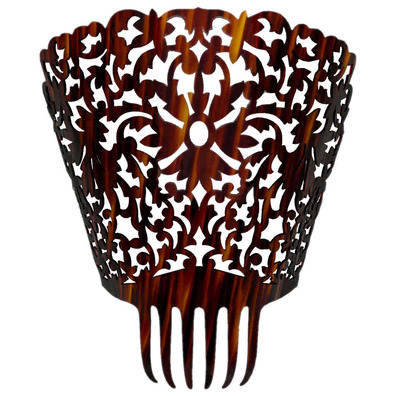Mantilla Comb | Spanish Hair Comb | Peineta
55,00€
Taxes includedCatholic product in stock. Products ready to be shipped. You can check the approximate delivery time during the purchase process.
Mantilla Comb | Spanish Hair Comb | Peineta
- Total height of 25 cm.
- 17 cm high not counting the spikes.
- Total width of 20 cm.
- Shell color.
- Handcrafted in Spain.
- Made of light and resistant resin.
- Includes six spikes to facilitate anchoring in the woman's hair bun.
Spanish Hair Comb for mantilla
A comb for mantillas is a traditional accessory used in Spain during Holy Week, Catholic weddings (brides or godmothers), popular festivals (such as the Fallas), and other types of liturgical celebrations.
The comb, also known as Spanish comb or peineta, is an ornament that women place in their hair, usually over a bun or low updo, whose main function is supporting the Spanish mantillas.
The comb for mantillas usually has a tile shape, with fine and tight teeth that allow firmly holding the mantilla without damaging it. Combs are often decorated with filigree, precious stones, or floral motifs.
Ancient combs: tortoiseshell and shell combs
Spanish combs, like mantillas, are garments that Spanish women and women from Hispanic traditional countries have worn for several centuries. Although there are earlier records, it is known that Spanish combs have been widely used by women of the 18th century. It is common to see women of wealthy social strata portrayed with this accessory in paintings of the time.
Primitive mantilla combs were made with noble materials such as gold and silver. The evolution in tastes causes the size of the combs to increase progressively. This evolution in designs results in noble materials being gradually replaced by others of animal origin. During the 19th century, combs made of tortoiseshell and shells became popular.
Tortoiseshell is a material obtained from the shells of some species of sea turtles. Tortoiseshell combs were highly appreciated for their beauty, durability, and quality during those years. They were lightweight and flexible.
Obtaining tortoiseshell is a very complex process involving the sacrifice of many turtles. Gradually, with new synthetic materials, tortoiseshells and shells were replaced.
Today, shell combs and tortoiseshell combs are still manufactured but not authentic. They are synthetic pieces made through artisanal processes that achieve high-level finishes.
How to put on a Spanish mantilla vail with a peineta
Putting on a mantilla using a comb is relatively simple. To place it correctly, we must follow the following steps.
First, arranging the hair appropriately before placing the comb is crucial. There are several hairstyles that a woman or girl can use. The most popular is a low bun that supports the hair comb. For a firm fixation, a hair net is suggested to secure the bun in position, preferably to avoid freshly washed hair.
During the comb placement, it is important to carefully insert its teeth into the bun. Hairpins firmly anchor the mantilla comb on the outside and inside, ensuring its stability and comfort throughout the day.
When adjusting the mantilla over the comb. It should look for a symmetrical location so that it hangs elegantly over the shoulders. Using reference points like the nose can help achieve the correct position.
To securely fasten the mantilla vail, invisible pins are used on the sides. Also, it is advisable to secure the mantilla to the dress at the shoulder area to keep it in position throughout the day.
As a final touch, a brooch adds elegance and style to the ensemble.



